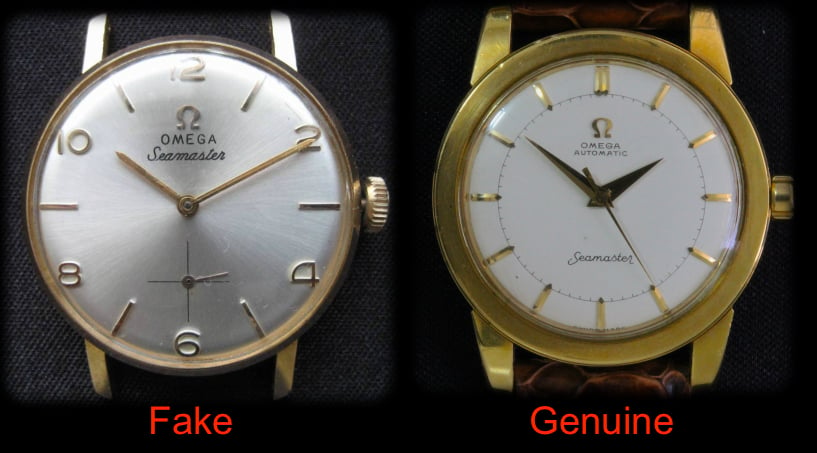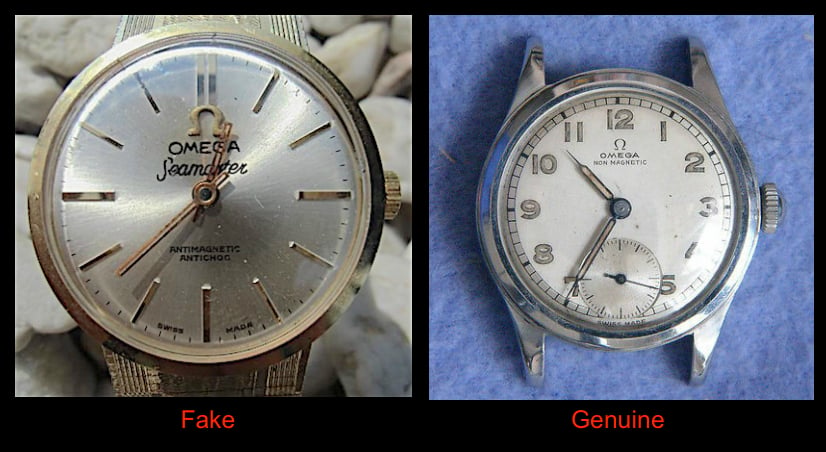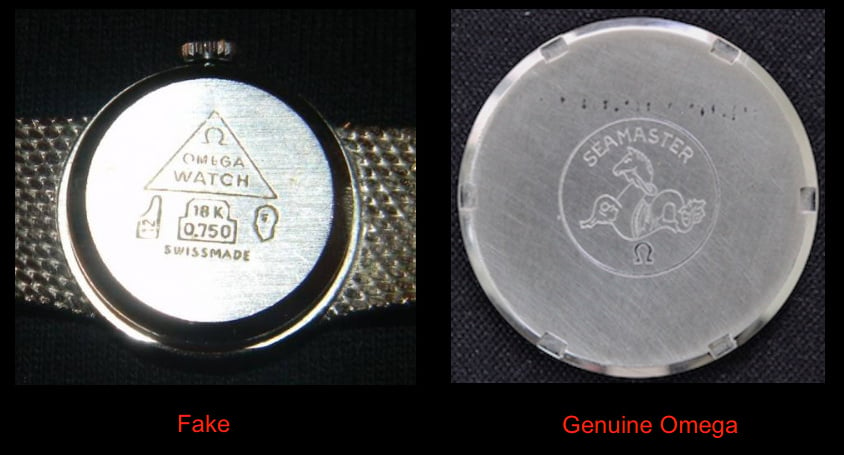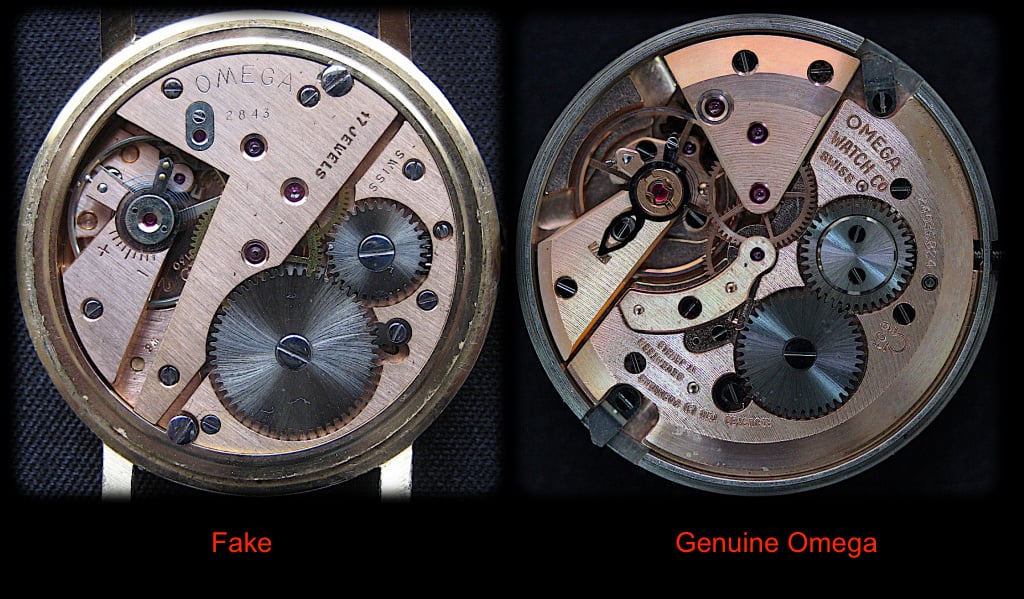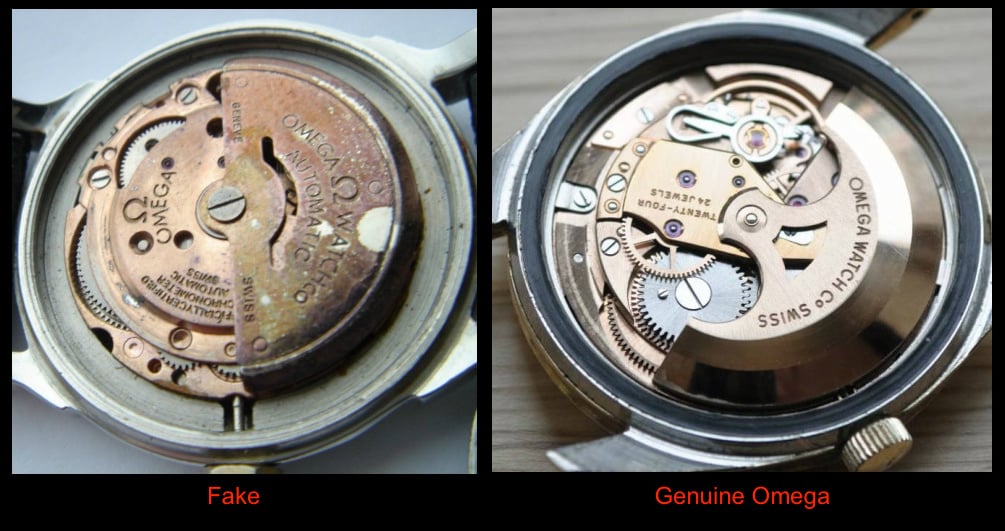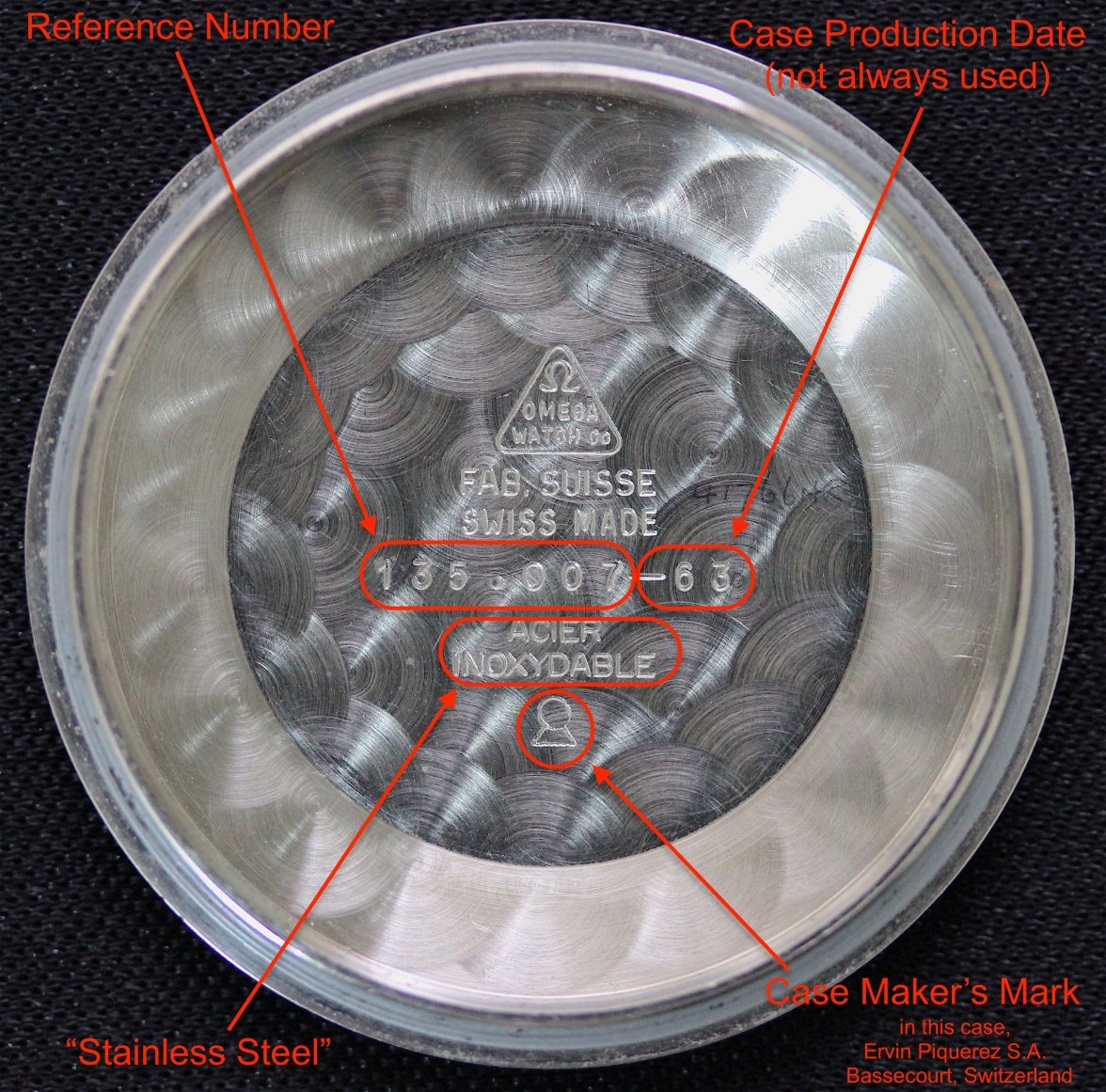JimInOz
··Melbourne AustraliaLet's start.
You have a watch, or are looking at buying from an auction or watch seller, and you need to satisfy yourself that you actually have, or are buying, a genuine vintage Omega watch and you would like to know all about it.
Well, the first thing you need to do is confirm that it actually is an OMEGA.
THE WATCH - FAKE OR REAL - QUICK OVERVIEW
One of the watches shown below is an Omega, the other is not, it’s a fake (or more correctly, a counterfiet).
A side trip to this educational post will help you figure out the DNA of your “Omega”.
So how can you tell from looking at the dial?
Basic tell tales on the dial of a fake watch are the words “Antimagnetic” and “Incabloc”. Omega never used these words on the dial. Omega rarely, if ever, noted jewel count on their dials, so if you see “17 Rubis” or “17 Jewels”, beware.
Two Omegas with "anti-magnetic" properties.
Notice the difference in the “magnetic” wording?
THE CASE
Omega cases have a certain genetic signature. After you’ve seen a few it’s like second nature to think “Hmmmmm, is this one right?” when you see a fake (or even an unusual model).
Many of the fake Omegas from the 1950s to the 1970s had impressive gold hallmarks etc. on the outside of the caseback. Omega never marked cases in this way. There are also stainless cases with makers stamps that may look like an Omega, but are just a pig in lipstick. Two examples are shown below. Which one is genuine?
More information on fake Omegas can be found here
THE MOVEMENT
If you see a photograph of a movement in an auction or a sale, or have it in your hand and it looks like one of these:
Even though one of them is engraved with Omega, it’s not a real Omega.
Fake movements were not confined to manual wind calibers, some awful fake autos can be found in vintage Omegas. The fake shown below is from a fake Constellation:
Now that you’ve figured out that you have a real Omega (or maybe not 🙁), most people ask “What model is it?
These days, with models like Speedmaster, Seamaster, etc, many people expect to see a model name on the dial.
While Omega watches have had “models” from very early on (1920s/30s at least) with names like “Argos”, “Fidelios”, “Euros” and even “Marine”, they were not labelled as such on the dial. Upon the introduction of automatic calibers in the 1940s, Omega started adding “Automatic” to the dial.
With the introduction of the Seamaster in 1948, Omega commenced the practice of naming watches by model, and adding the script to the dial, so we now had Seamaster, Speedmaster, Railmaster, Gèneve, De Ville, Seamaster De Ville, Ranchero, and most famously from the golden era, the Constellation and it’s American cousin, the Globemaster. The preceding models are just a sample of Omega’s range in the 1940 to 1980 period.
SO HOW DO I IDENTIFY IT?
Unlike many of the fakes, an Omega hides its secrets inside the watch.
The model or reference number is usually found either stamped or engraved on the inside of the caseback.
The caliber ("engine type") is usually engraved on one of the movement bridges, or sometimes stamped on the main plate beneath the balance wheel. The serial or production number will also be engraved on the movement. Older movements, mainly pocket watch calibers may have the caliber on the main plate under the dial. There are other ways to identify a movement, such as the shape of the plates and bridges, position of the click and screws, and shapes of the setting lever parts, but this is for more advanced research.
So with the reference number inside the caseback, you can consult the Omega Vintage Database (OVDB) to identify the model of the watch.
Using this as an example:
When entered on OVDB, a reference number of 135.007 (we ignore the -63 date stamp), will reveal this:
Notes on the OVDB:
The OVDB is only a guide. Like many things created by humans, it’s not perfect, but it’s a good starting point for research.
It does not contain all references, and may contain some discrepancies.
It shows one example of most references, but does not show all variations of dial/hands configurations or case materials.
It gives the introduction year for a given reference, not the only year it was produced.
With the 3.3 digit reference numbers, you need to add a zero to search the OVDB, so 135.007 should be entered as 135.0007.
Tip: While checking the OVDB, you can use the information to see if your movement is the correct caliber for your reference.
The serial number of the movement will give an approximate date, usually the production date of the movement. With high volume production (e.g. stainless steel Seamasters) this date will be close to the actual time that the movement came together with its case. Lower production pieces (solid gold editions etc) may use movements that have been held in stock so the date may not be as accurate.
In this example, the serial number in the 20 million range puts the movement production date at approximately 1963 which agrees with the date in the caseback and the OVDB entry. There are a number of Omega Serial Number charts on the internet that can be used to date your movement.
You can also request an “Extract from the Archives” from Omega that will provide further information about your watch.
We've been dealing with fake versus real so far and haven't considered "frankens", "basket cases" or "redials", but pay a visit here and this will help with your education.
OK, then how do I get to these numbers?
⚠️ If you have the skills and the correct tools ⚠️, you can remove the caseback.
The variations of case closure usually fall into one of the following categories:
Screw back - Where the caseback plate is threaded and screws into the case, usually identified by three or six notches on the outer periphery of the caseback.
Press In - Where the caseback is a force fit and is pressed into the case with a special tool.
Snap Back - Similar to a Press In, but the caseback is held by detents on the case.
Monocoque - A one piece case with no removable back. The movement is removed from the front after removing the bezel/crystal assembly and crown.
Unicoc or Unishell - Similar to the Monocoque, a one piece case with no removable back and where the movement is removed from the front after compressing and removing the crystal and crown.
Compressor or Screw Down - Where the caseback plate is secured to the case with screws (different variations).
Another style is what I call a “tuna can”. This is a circular “can” containing the movement and sealed by the crystal held by a hard gasket, notable on the Omega Seamster Cosmic 2000 where the can fits into the mid case ring and is secured by gaskets. Another unusual case closure was used on the Omega Marine, but most of the watches we see will use one of the above methods.
⚠️ If you don’t have the skills or tools (or think you have the skills), find a reliable watchmaker to remove the caseback and expose Omega’s secrets ⚠️.
Now that you’re able to identify your watch, you can spend some time sharing it with us. We all love to see vintage watches, even if it’s not a “Speedie Barn Find” or a “Grandfather’s Old Watch”, we still love ‘em all.
If you still have questions after your investigation, you can create a thread for your enquiry.
A guide to content required is shown here.
Finally, I’d like to acknowledge the assistance provided by other forum members in the development of this guide. Thank you Gentlemen.👍
You have a watch, or are looking at buying from an auction or watch seller, and you need to satisfy yourself that you actually have, or are buying, a genuine vintage Omega watch and you would like to know all about it.
Well, the first thing you need to do is confirm that it actually is an OMEGA.
THE WATCH - FAKE OR REAL - QUICK OVERVIEW
One of the watches shown below is an Omega, the other is not, it’s a fake (or more correctly, a counterfiet).
A side trip to this educational post will help you figure out the DNA of your “Omega”.
So how can you tell from looking at the dial?
Basic tell tales on the dial of a fake watch are the words “Antimagnetic” and “Incabloc”. Omega never used these words on the dial. Omega rarely, if ever, noted jewel count on their dials, so if you see “17 Rubis” or “17 Jewels”, beware.
Two Omegas with "anti-magnetic" properties.
Notice the difference in the “magnetic” wording?
THE CASE
Omega cases have a certain genetic signature. After you’ve seen a few it’s like second nature to think “Hmmmmm, is this one right?” when you see a fake (or even an unusual model).
Many of the fake Omegas from the 1950s to the 1970s had impressive gold hallmarks etc. on the outside of the caseback. Omega never marked cases in this way. There are also stainless cases with makers stamps that may look like an Omega, but are just a pig in lipstick. Two examples are shown below. Which one is genuine?
More information on fake Omegas can be found here
THE MOVEMENT
If you see a photograph of a movement in an auction or a sale, or have it in your hand and it looks like one of these:
Even though one of them is engraved with Omega, it’s not a real Omega.
Fake movements were not confined to manual wind calibers, some awful fake autos can be found in vintage Omegas. The fake shown below is from a fake Constellation:
Now that you’ve figured out that you have a real Omega (or maybe not 🙁), most people ask “What model is it?
These days, with models like Speedmaster, Seamaster, etc, many people expect to see a model name on the dial.
While Omega watches have had “models” from very early on (1920s/30s at least) with names like “Argos”, “Fidelios”, “Euros” and even “Marine”, they were not labelled as such on the dial. Upon the introduction of automatic calibers in the 1940s, Omega started adding “Automatic” to the dial.
With the introduction of the Seamaster in 1948, Omega commenced the practice of naming watches by model, and adding the script to the dial, so we now had Seamaster, Speedmaster, Railmaster, Gèneve, De Ville, Seamaster De Ville, Ranchero, and most famously from the golden era, the Constellation and it’s American cousin, the Globemaster. The preceding models are just a sample of Omega’s range in the 1940 to 1980 period.
SO HOW DO I IDENTIFY IT?
Unlike many of the fakes, an Omega hides its secrets inside the watch.
The model or reference number is usually found either stamped or engraved on the inside of the caseback.
The caliber ("engine type") is usually engraved on one of the movement bridges, or sometimes stamped on the main plate beneath the balance wheel. The serial or production number will also be engraved on the movement. Older movements, mainly pocket watch calibers may have the caliber on the main plate under the dial. There are other ways to identify a movement, such as the shape of the plates and bridges, position of the click and screws, and shapes of the setting lever parts, but this is for more advanced research.
So with the reference number inside the caseback, you can consult the Omega Vintage Database (OVDB) to identify the model of the watch.
Using this as an example:
When entered on OVDB, a reference number of 135.007 (we ignore the -63 date stamp), will reveal this:
Notes on the OVDB:
The OVDB is only a guide. Like many things created by humans, it’s not perfect, but it’s a good starting point for research.
It does not contain all references, and may contain some discrepancies.
It shows one example of most references, but does not show all variations of dial/hands configurations or case materials.
It gives the introduction year for a given reference, not the only year it was produced.
With the 3.3 digit reference numbers, you need to add a zero to search the OVDB, so 135.007 should be entered as 135.0007.
Tip: While checking the OVDB, you can use the information to see if your movement is the correct caliber for your reference.
The serial number of the movement will give an approximate date, usually the production date of the movement. With high volume production (e.g. stainless steel Seamasters) this date will be close to the actual time that the movement came together with its case. Lower production pieces (solid gold editions etc) may use movements that have been held in stock so the date may not be as accurate.
In this example, the serial number in the 20 million range puts the movement production date at approximately 1963 which agrees with the date in the caseback and the OVDB entry. There are a number of Omega Serial Number charts on the internet that can be used to date your movement.
You can also request an “Extract from the Archives” from Omega that will provide further information about your watch.
We've been dealing with fake versus real so far and haven't considered "frankens", "basket cases" or "redials", but pay a visit here and this will help with your education.
OK, then how do I get to these numbers?
⚠️ If you have the skills and the correct tools ⚠️, you can remove the caseback.
The variations of case closure usually fall into one of the following categories:
Screw back - Where the caseback plate is threaded and screws into the case, usually identified by three or six notches on the outer periphery of the caseback.
Press In - Where the caseback is a force fit and is pressed into the case with a special tool.
Snap Back - Similar to a Press In, but the caseback is held by detents on the case.
Monocoque - A one piece case with no removable back. The movement is removed from the front after removing the bezel/crystal assembly and crown.
Unicoc or Unishell - Similar to the Monocoque, a one piece case with no removable back and where the movement is removed from the front after compressing and removing the crystal and crown.
Compressor or Screw Down - Where the caseback plate is secured to the case with screws (different variations).
Another style is what I call a “tuna can”. This is a circular “can” containing the movement and sealed by the crystal held by a hard gasket, notable on the Omega Seamster Cosmic 2000 where the can fits into the mid case ring and is secured by gaskets. Another unusual case closure was used on the Omega Marine, but most of the watches we see will use one of the above methods.
⚠️ If you don’t have the skills or tools (or think you have the skills), find a reliable watchmaker to remove the caseback and expose Omega’s secrets ⚠️.
Now that you’re able to identify your watch, you can spend some time sharing it with us. We all love to see vintage watches, even if it’s not a “Speedie Barn Find” or a “Grandfather’s Old Watch”, we still love ‘em all.
If you still have questions after your investigation, you can create a thread for your enquiry.
A guide to content required is shown here.
Finally, I’d like to acknowledge the assistance provided by other forum members in the development of this guide. Thank you Gentlemen.👍
